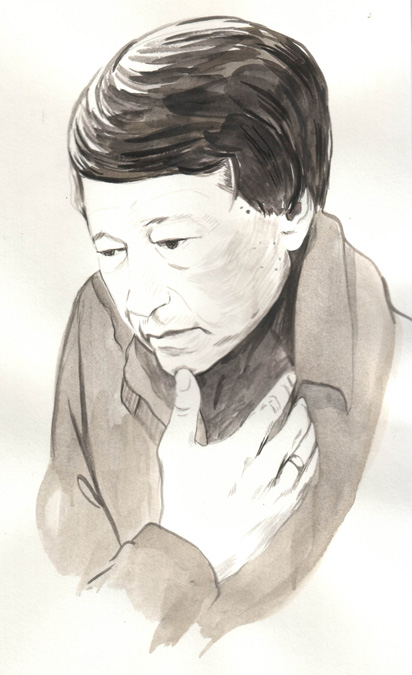ARCHIVE
REMEMBERING BARRY HANNAH (1942–2010)

Illustration by KEVIN CHRISTY
Monday, March 15, 2010
By Nathan Kosub
Barry Hannah was a hero of mine. He belongs on Mt. Rushmore, beside Duke Ellington, Crazy Horse and Loretta Young. I went to college in Maine, where one year a professor from South Carolina assigned “Testimony of Pilot,” Hannah’s short story about two friends in the same high school band. My father had played trumpet in high school and college and, for the first time in my life, I took my father’s band experience seriously.
When I moved to Mississippi for graduate school, I worked a job at a bookstore in Oxford in the evenings. There is a small café on the second floor, and on my second night at work, Barry Hannah walked upstairs. He did it slowly—his health was poor. I recognized him from his photographs on the wall. The walls of the bookstore were lined with hundreds of authors’ 8x10s, but there was no author more prevalent there than Hannah. In one picture, he wore suspenders. In another, a leather jacket over a long-sleeve shirt adorned in tiny carnations.
He wore suspenders the night I met him. I remember because he introduced himself. As he didn’t recognize me, he surmised I must be new. “I’m Barry Hannah,” he said. “It’s a pleasure to meet you.” He drank iced coffee with plenty of milk and sugar. Sometimes in town he’d carry an energy drink—one twice the size of a can of Coca-Cola.
He loved tennis, and the silence of municipal concrete on a muggy Mississippi night informs his stories more than violence does. He is famous for violence. The hero of “Testimony of Pilot” flies F-14s and bombs targets in Vietnam; his girlfriend, a stewardess, is killed by hijackers. “The poor pilot,” Hannah wrote, “the poor passengers, the poor stewardesses were all splattered like flesh sparklers over the water just out of Cuba.”
But Barry Hannah was, in spite of such passages (and the many guns he owned), a peaceful man. Regarding guns, he told Lacey Galbraith at The Paris Review in 2004, “they mean nothing to me except nice little mechanisms that shoot beer cans. They are a skill, history, and it’s the same thing with a motorcycle. It’s a sort of skill through which you are able to experience more life. There’s no heroic code there.”
In the early Eighties, Hannah lived in San Pedro, California. I like this part of his biography because I love movies. “[Robert] Altman loved Ray,” Hannah told The Paris Review, “but he didn’t want to shoot it. He just wanted to meet me.” In his spare time, Hannah visited friends at Miramar Naval Air Base in San Diego. “The ones I was with,” he wrote in the anthology A World Unsuspected: Portraits of a Southern Childhood, “along with an actual heroic pilot friend of mine, John Quisenberry, were fine guys, but I missed the old leather jackets. At thirty-nine years of age, knowing all about modern F-14s and the like, I was yet hurt a little that they were just sitting there, drinking tea and slight beer, in boring tan short-sleeve outfits, looking just a little more menacing than clerks at WalMart’s [sic], where I buy my ammo here in Oxford. America was at peace, these were reserve flyers on their monthly tests, but still I was hurt. I was having more adventures on Quisenberry’s Triumph motorcycle getting back and forth from San Pedro to Bob Altman’s studio in Santa Monica than they were, it appeared to me.”


